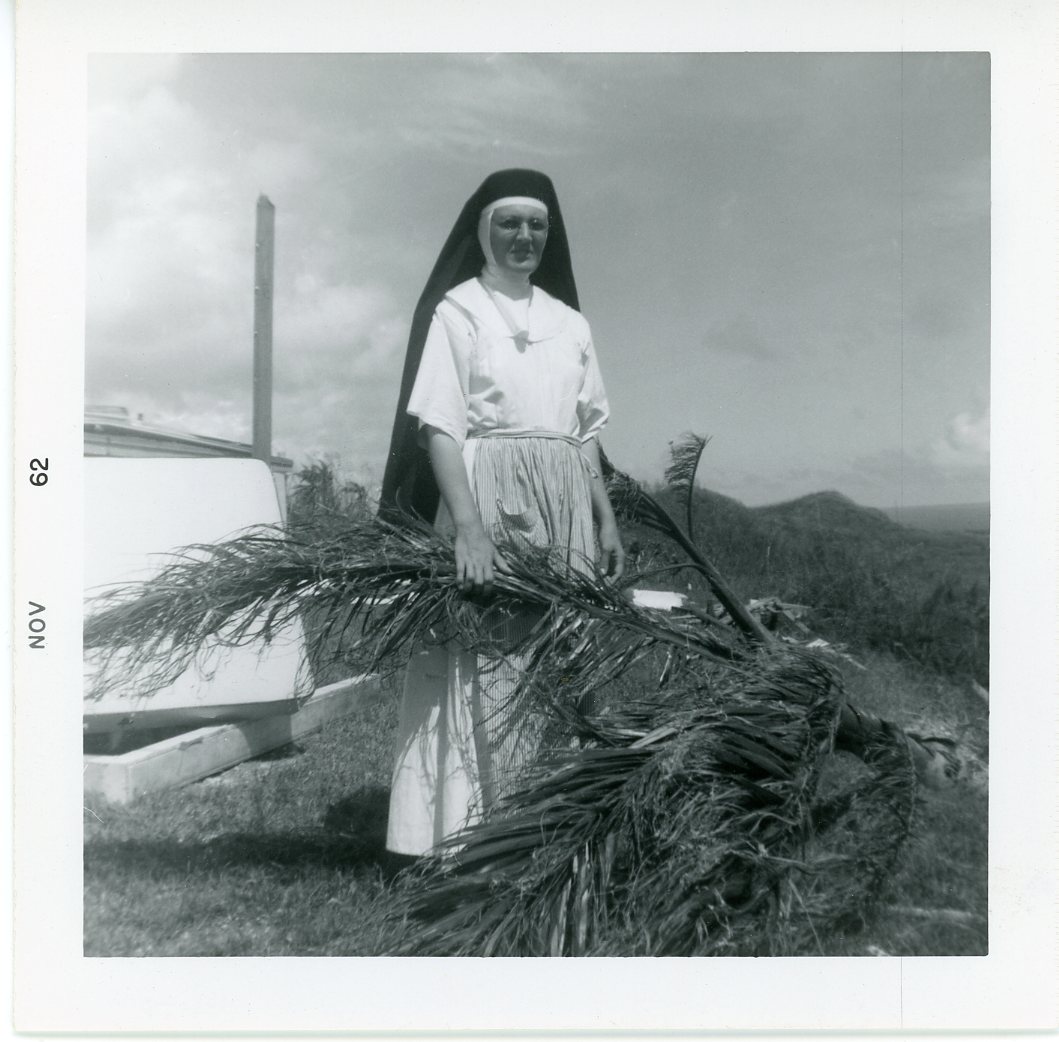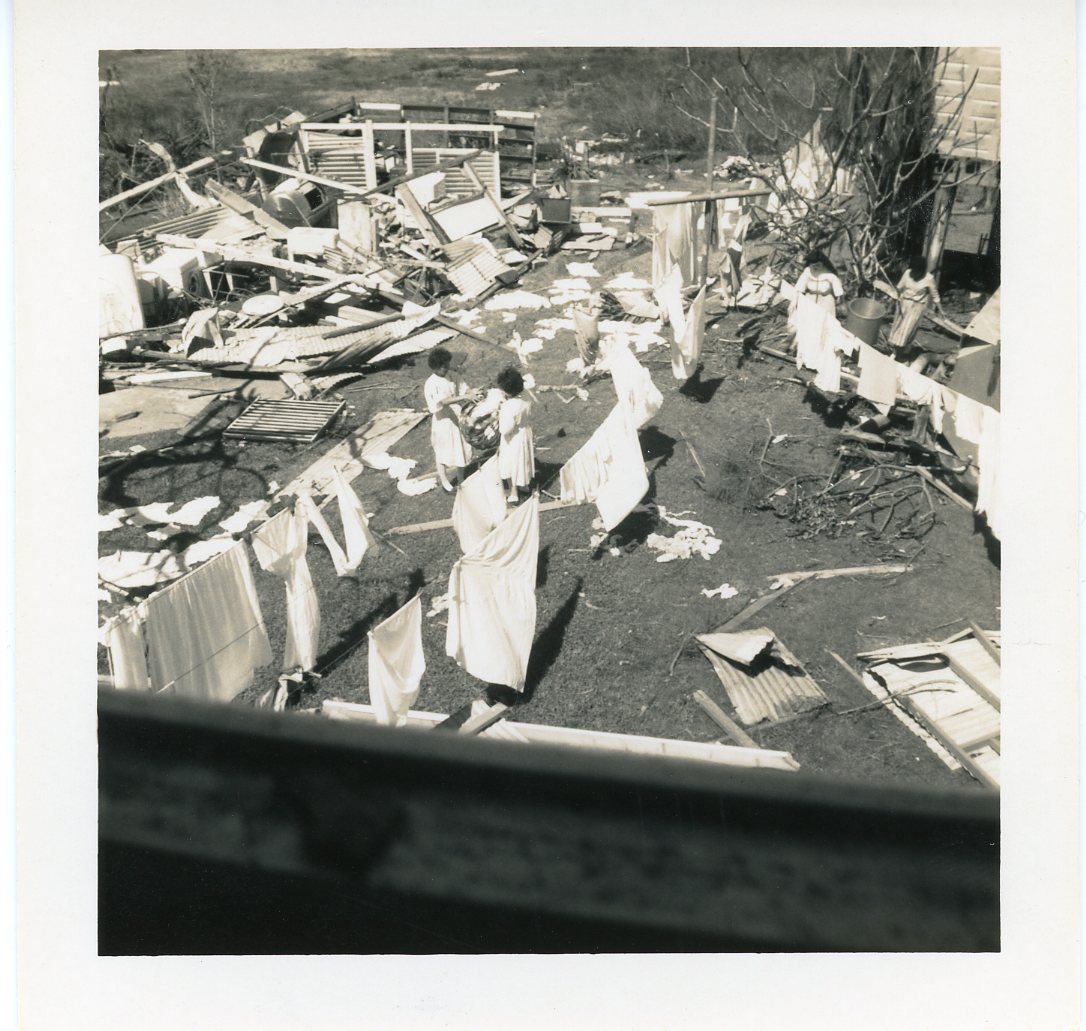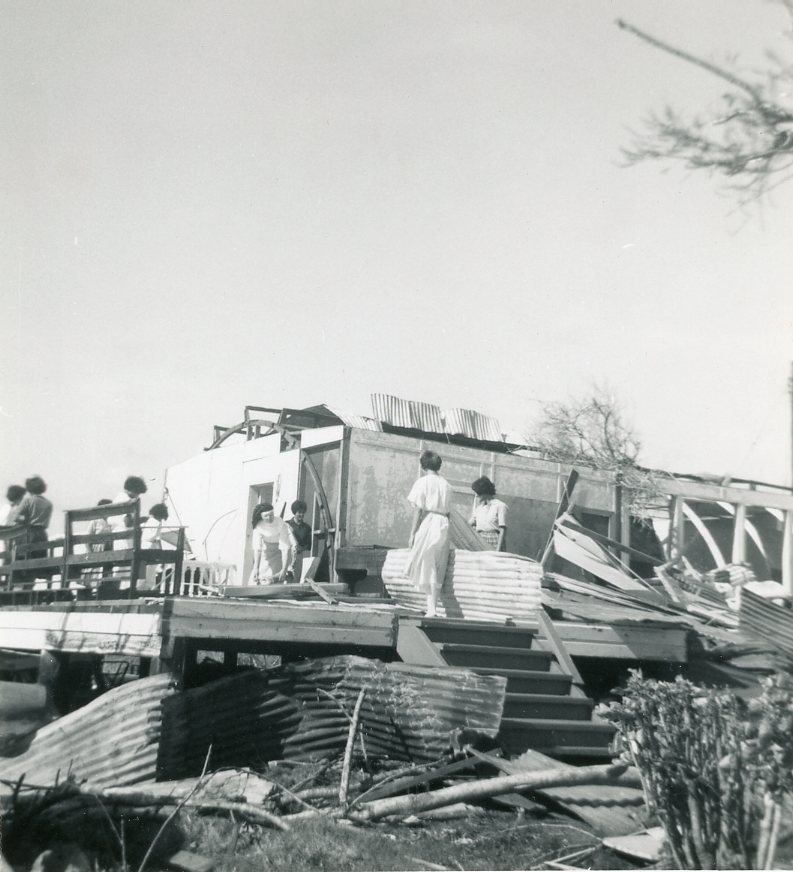On November 11, 1962, Typhoon Karen devastated the island of Guam. Eleven people were killed, and 95% of homes were destroyed, leaving 45,000 people, mostly Guamanians, homeless. Fifty-three School Sisters of Notre Dame, eight postulants, and ten aspirants living in four locations on the island lived through the storm and recorded their experiences in letters, chronicle entries, oral histories, and photographs. Here is the story of the worst natural disaster to ever hit Guam as experienced by the sisters who lived it.
The following accounts were written by sisters living at the two locations in Yona – St. Francis Convent, Church and School and the Aspiranture with the adjacent Quonset convent. Yona experienced more destruction than any other area on the island, with an estimated 97% of structures destroyed or damaged.
The Storm
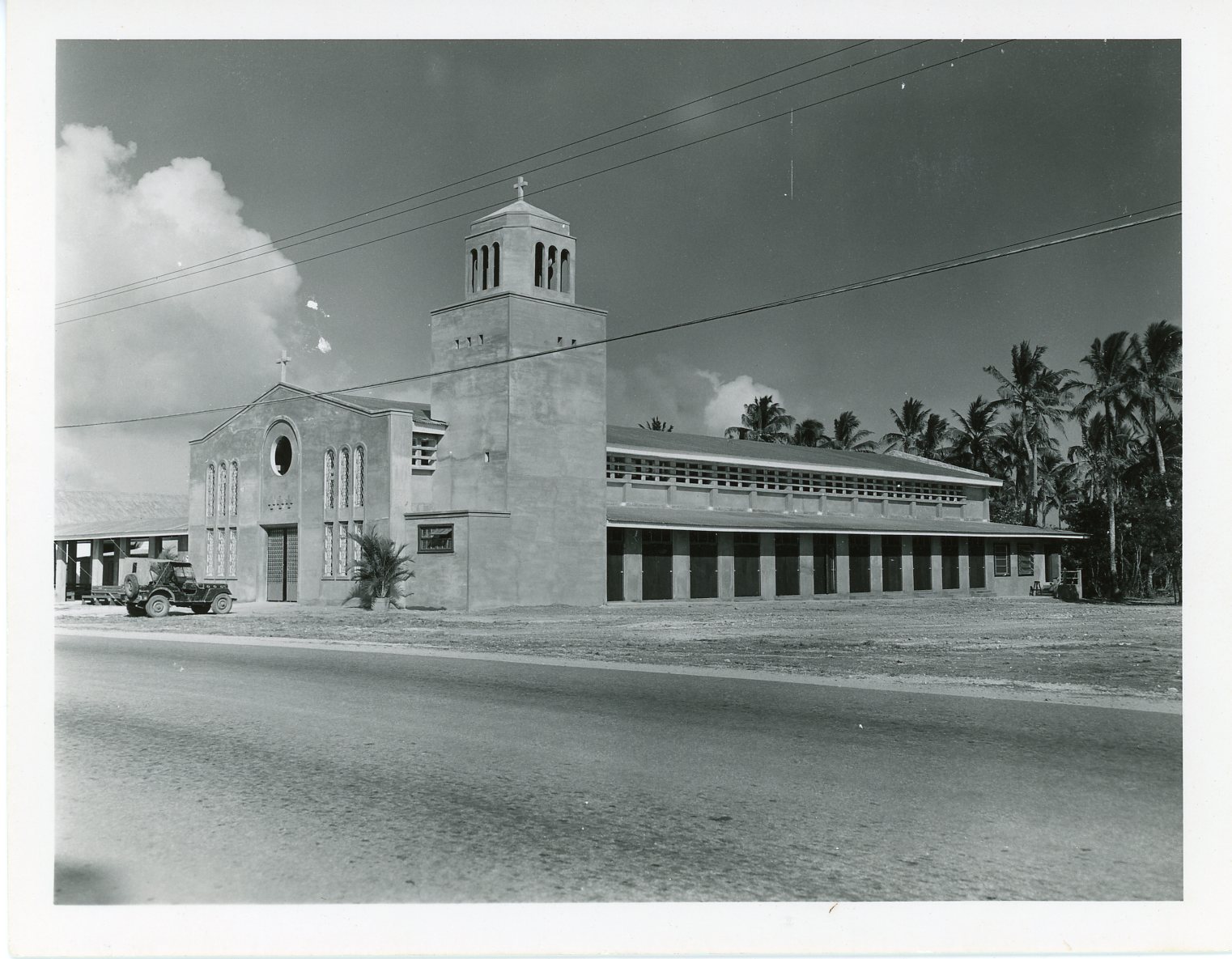 “Typhoon warnings were first broadcast as early as Thursday, Nov. 8, but we Sisters at Yona did not hear them. On Sunday, November 11 – the memorable Sunday of our ordeal and survival – the radio announced Condition One, which means that Guam was in the direct path of the hurricane. All day Sunday the strong, driving rain battered against our buildings at St. Francis, Yona. The radio reported ocean wave breaking against our shoreline as high as eleven feet. Men from our parish began to board up the east side of our convent Sunday morning. By evening it was clear that no storm was ever like this before…”
“Typhoon warnings were first broadcast as early as Thursday, Nov. 8, but we Sisters at Yona did not hear them. On Sunday, November 11 – the memorable Sunday of our ordeal and survival – the radio announced Condition One, which means that Guam was in the direct path of the hurricane. All day Sunday the strong, driving rain battered against our buildings at St. Francis, Yona. The radio reported ocean wave breaking against our shoreline as high as eleven feet. Men from our parish began to board up the east side of our convent Sunday morning. By evening it was clear that no storm was ever like this before…”
…With a kerosene lamp we dashed for the Blessed Sacrament and ran over to the Asp. [Aspiranture] building. The rest was a nightmare. The 23 of us went from room to room as the roof blew off, windows crashed and rain came down. We ended up in a narrow corridor crouched between mattresses and wet blankets free from flying glass for 6-8 hours. It was awful, how we prayed!!!”
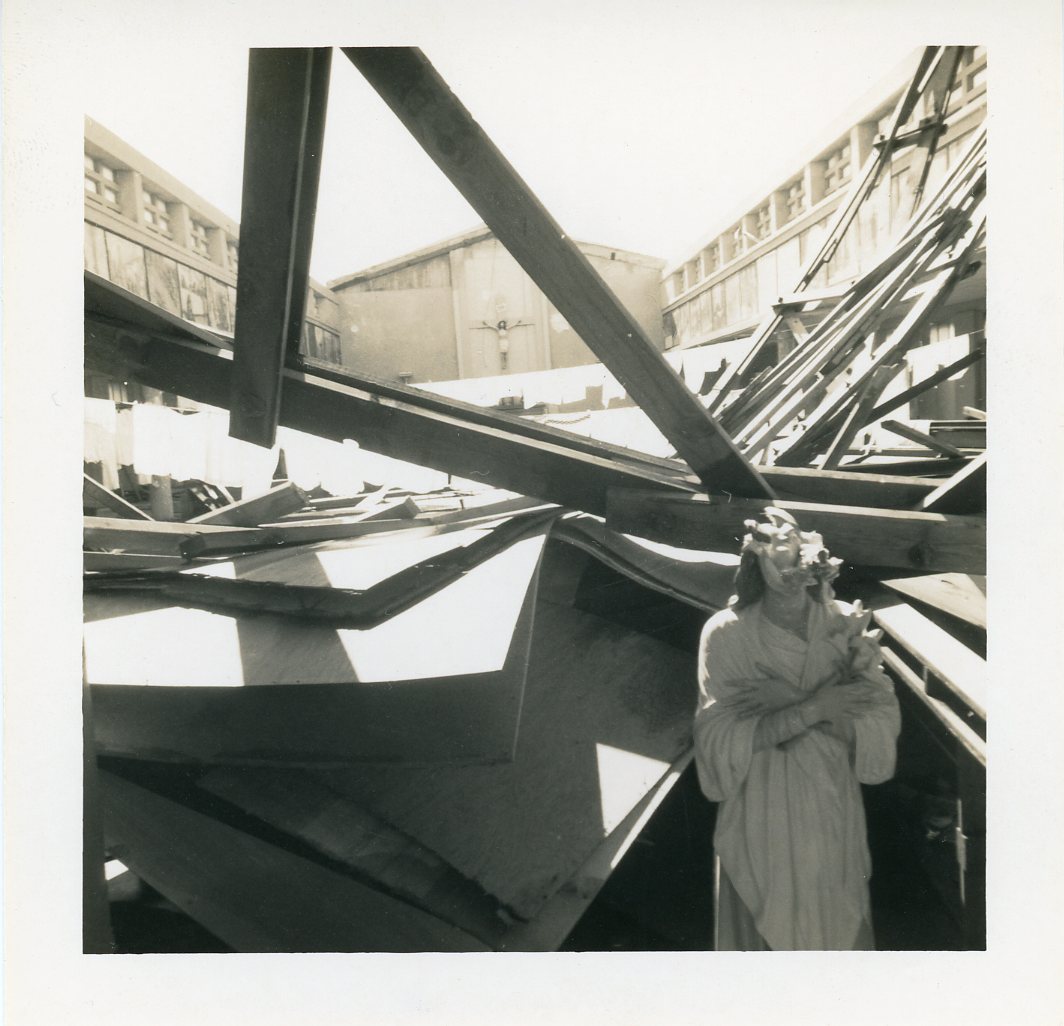
Some outside doors were the first to go; they were torn off and blown away. I looked up at the chapel ceiling. A large part of it was no longer there; neither was the roof – I saw only the gray sky through the rafters…I called all the Sisters into our small sacristy, which at least had a roof. The Sisters in there had been “spelling” each other for hours holding a large statue of St. Joseph while they leaned against the trembling outside door. We rode out the rest of the storm in this tiny room – all 25 of us.”
Devastation
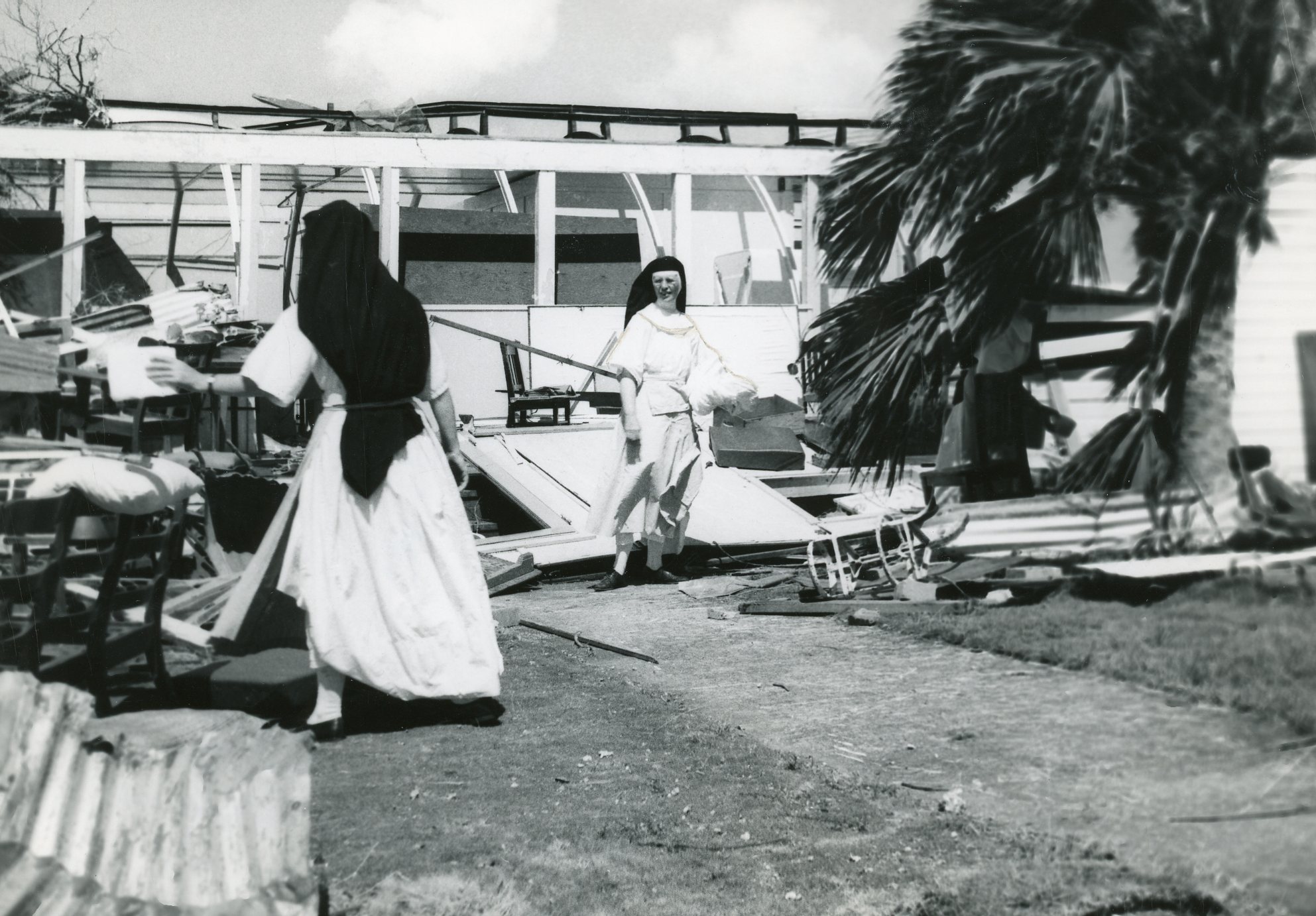 [Aspiranture] “When daylight slowly came, we gingerly picked our way through the broken window-glass and the smashed dishes. We were horrified in looking out the side window to see the roof off our Quonset-convent and the three outer walls ripped off. All around lay sheets of tin roofing, uprooted trees, and flown debris.
[Aspiranture] “When daylight slowly came, we gingerly picked our way through the broken window-glass and the smashed dishes. We were horrified in looking out the side window to see the roof off our Quonset-convent and the three outer walls ripped off. All around lay sheets of tin roofing, uprooted trees, and flown debris.
The second-floor ceiling came to meet us as we went upstairs to the Study Hall. One look and all I could do was grab our habit sleeve and cry out loud into it. All over the floor were dozens of water-soaked Notre Dame dolls, thousands upon thousands of Christmas cards – our Holiday Fair work of months cancelled in one night. Too heartsick to care, we went downstairs and lay on the damp mattresses that we had pulled out of the cells earlier as a protection against the fierce winds. We were still cold, perhaps from the cell-door wet drapes in which we had to bundle ourselves while we had kept our prayerful and anxious vigil.”
[St. Francis Convent] “About four o’clock in the morning after the typhoon, we served hot cocoa and chicken-noodle soup, and Japanese crackers, also called typhoon crackers. Thank God, we still had our gas stove. The Sisters fell asleep in the refectory. In my bedroom there were five Sisters asleep on one bed. I [Sr. Eucharita Cruz] was one of the five…Later in the morning the whole Aspiranture moved in with us. We weren’t sorry. They brought all their deep-freeze food along, including 7 turkeys. We had turkey for three days in a row, even for breakfast…”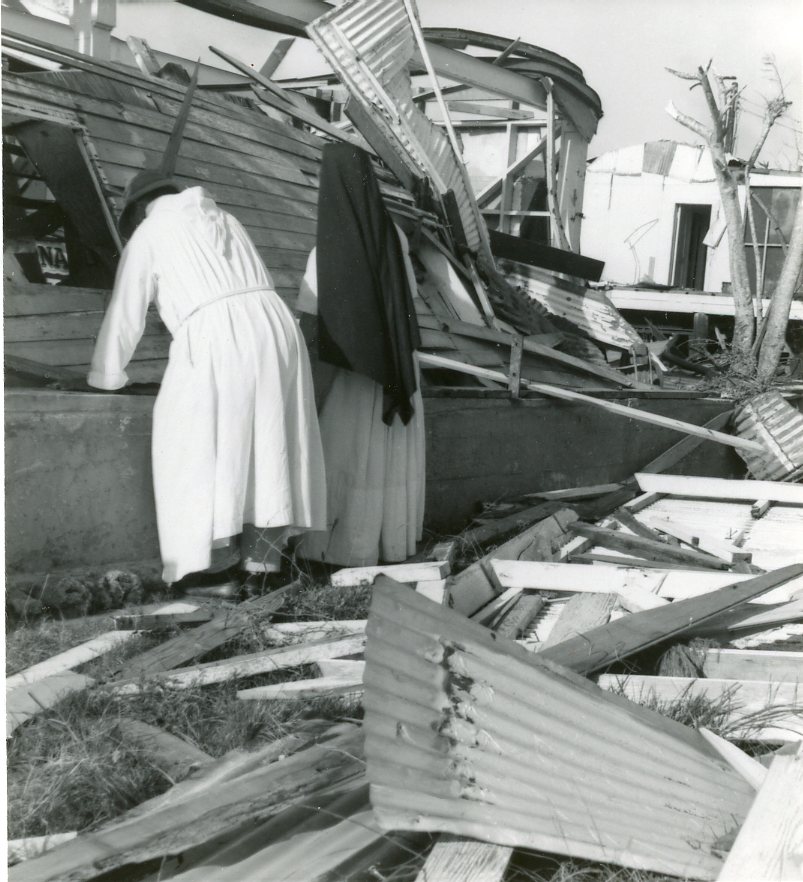
“In the meantime, we ‘mopped up’. We had thousands of pounds of flour (Hot Lunch) to dispose of. What was salvageable the Postulants and Aspirants took to the villagers; the rest we had to burn. We all wore masks, Roy-Rogers-fashion and I gave the young ones gum to chew to keep the morale up and the stomach down…”
“The rest of the salvaging cannot be described. It is an experience only actuality can give. Picking out valuable articles from a pile of rubble, dirt and falling timber; shoveling out piles of broken glass and water soaked books; finding a fork amidst a pile to be burned; decaying food products being carried to the bonfire; and the ever-present question, “Where to put this?” are only a few of the day by day duties. Each day we did as much as we could, returning to St. Francis for meals and sleeping. Night comes early in the tropics, so each day ended with the approaching darkness. Evenings found us gathered together usually for signing or listening to news on the transistor radio.”
Moving Forward
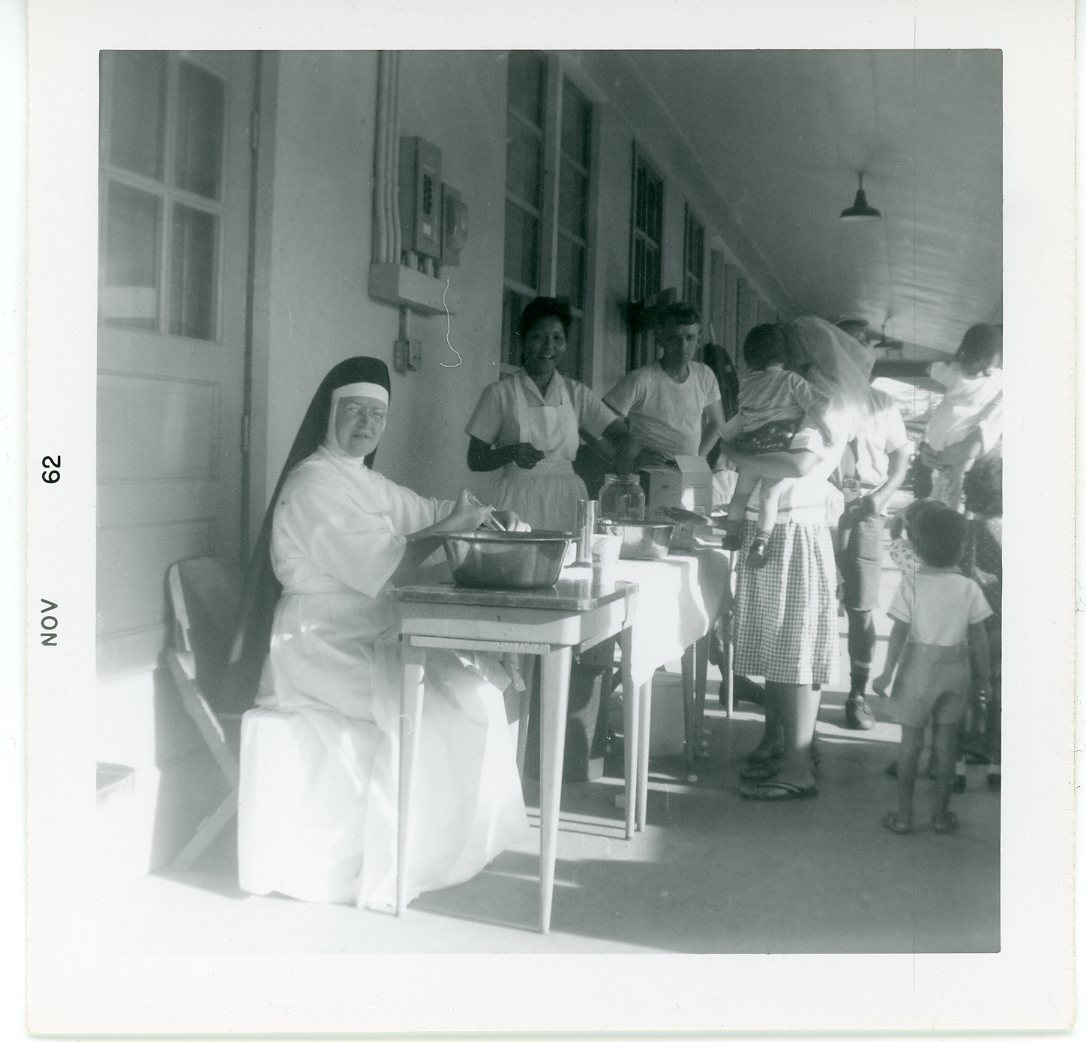 “In the meantime the Red Cross opened Field Kitchens in many villages; 1000 large, heavy tents were air-lifted to Guam to serve as temporary shelters for the thousands of homeless; 400 US Marines arrived within days to help rebuild temporary homes on Guam; typhoid shots were given to young and old. And thanks be to God, I think it was within a week that water was again running through our pipes. We have been told it would take up to 60 days for us to have power again.”
“In the meantime the Red Cross opened Field Kitchens in many villages; 1000 large, heavy tents were air-lifted to Guam to serve as temporary shelters for the thousands of homeless; 400 US Marines arrived within days to help rebuild temporary homes on Guam; typhoid shots were given to young and old. And thanks be to God, I think it was within a week that water was again running through our pipes. We have been told it would take up to 60 days for us to have power again.”
“Now – Our Sisters and friends in the States are probably wondering how we could be of help directly to the people of our village of Yona. As soon as we ourselves got out from under, we Sisters helped in the rationing of Red Cross food and clothing supplies, registering typhoid shots, and in just being around when a helping hand or a friendly word were needed…”
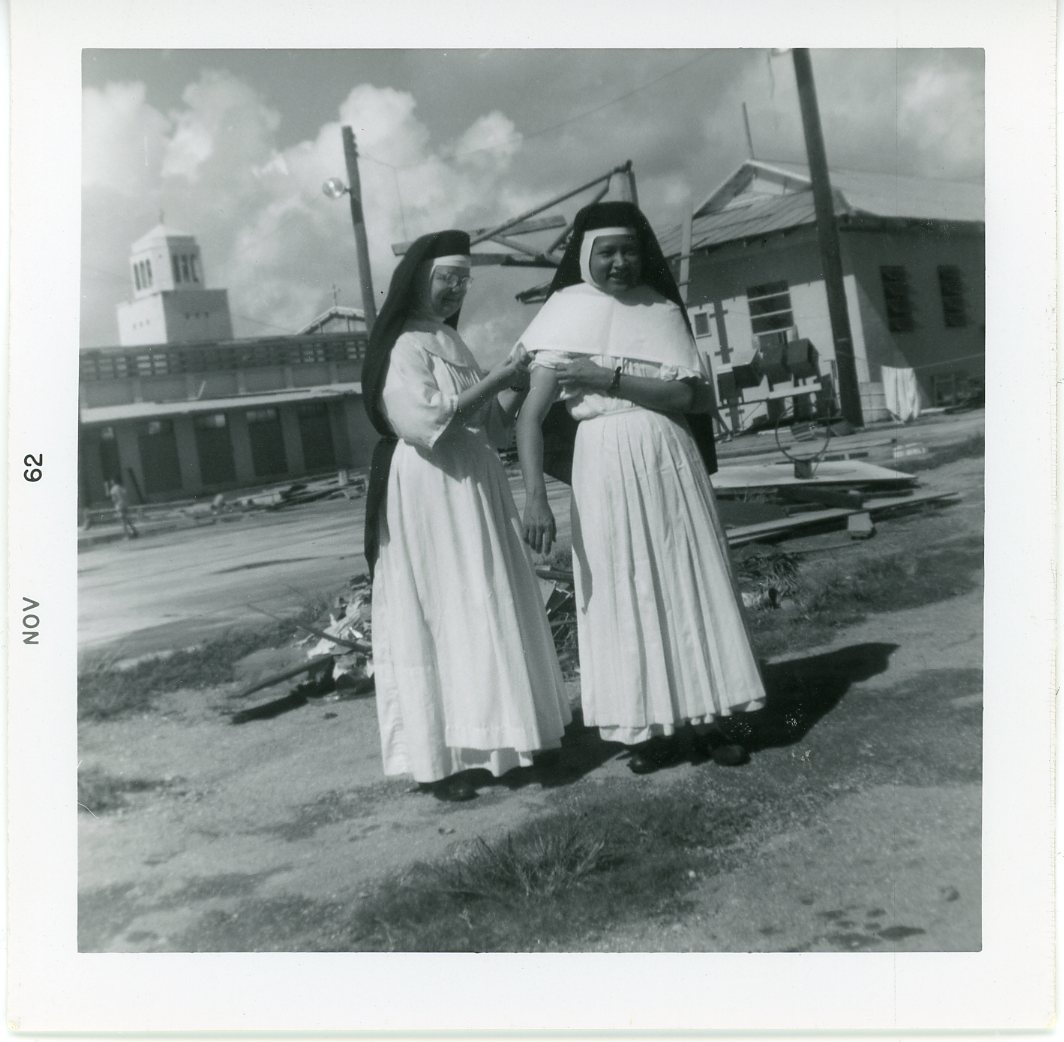
“On November 26 we re-opened school in half-day sessions, the Sisters alternating in using the same classrooms. Our auditorium triples as church, classroom, and study hall for children awaiting transportation. Here also we held our December P.T.A. meeting right on schedule…Concerning our pupils, more than 95% of them came back on the day school re-opened. Even though our school situation is far from adequate, many of our children are better housed and fed while in school than they would be in their own homes. For instance, one family of 7 are living in a cave. Another of 14 persons is crowded into a 3-walled shell covered over with pieces of tin. Many others are doubling up with more fortunate relatives. Some are still living in the tents put up by the Marines three weeks ago.”
“Slowly we are betting back to a semblance of normal. The villages still look pretty beaten up. Property losses are estimated at close to 31 million. Ninety-seven present of Yona was destroyed…The people have been magnificent under this unusual cross God sent us. This one came as a might breath of His love.”
“Is it true that you are wearing civilian clothes?”
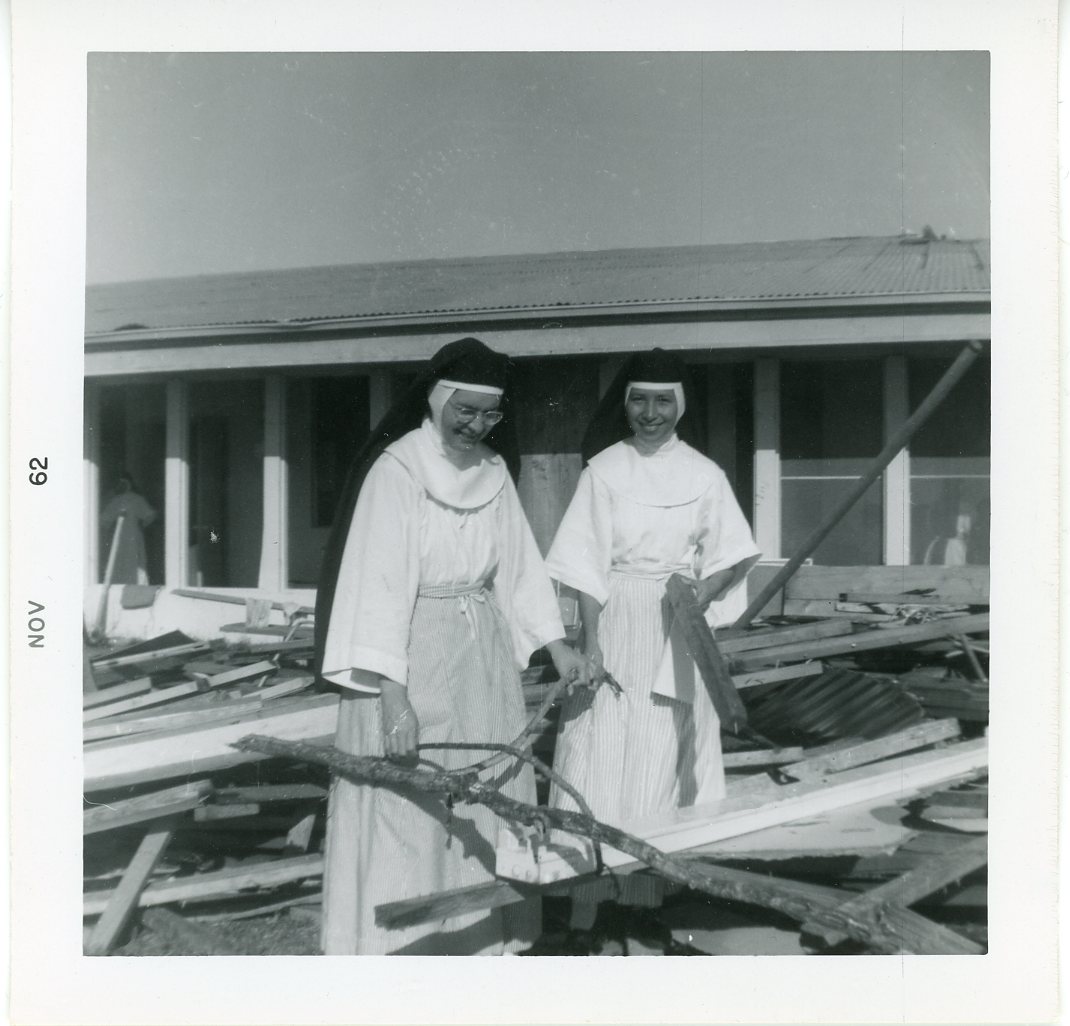 After the typhoon, the sisters in Guam were asked whether the rumors that they were wearing civilian clothes. The following is a portion of their response:
After the typhoon, the sisters in Guam were asked whether the rumors that they were wearing civilian clothes. The following is a portion of their response:
“There’s one thing about starch: it doesn’t stand up under a steady downpour of rain. We couldn’t wash or iron our regular wimples. All of our white habits were wet and couldn’t dry in the continuous rain. Our shoes fell apart or shrank after several days of walking in rivers of water. So you’d meet Sisters wearing black or white kimonos, zoris, bedroom slippers, and our off-the-face driver’s veil. For two days Sisters Mary Roman and Florian cut down and sewed our unstarched wimples to be short and round like dress-collars, and the whole community switched over to these. The Sisters at Agat had to resort to the white plastic material from Clorox bottles to use as makeshift wimples. Later all the other missions wore the Yona style short, round wimples. Pairs of grey pumps and brown oxfords, donated before the typhoon, were now being worn by the Sisters. Sister Therese took the prize for informal dress by wearing her black Stateside woolen habit with a white cincture. We were copiously covered (as Nuns always are) except that nothing was exactly according to regulations.”
See the full text of the documents cited above by clicking the following:
Guam Aspiranture chronicle, 1962
Letter from St. Francis, December 1962
Letter by Sister Ellen Jean Klein to her parents at the time of Typhoon Karen
More photos from the aftermath of Typhoon Karen. . .
